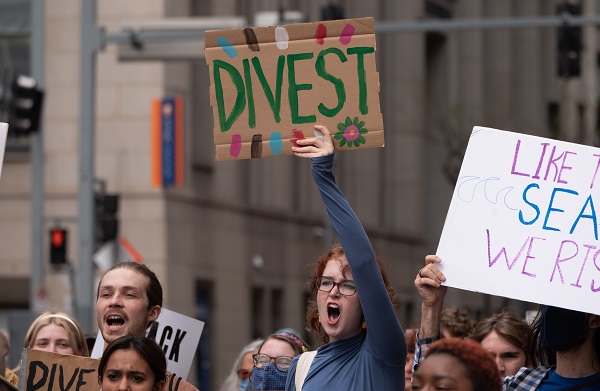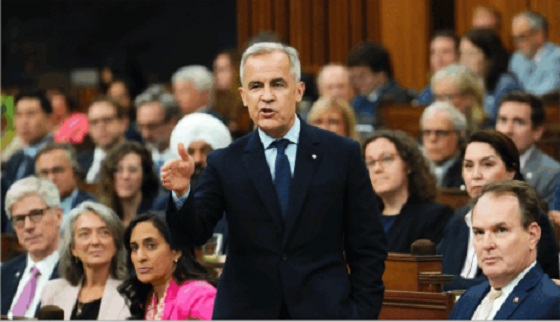Energy
Anti-LNG activists have decided that they now actually care for LNG investors after years of calling to divest

From Resource Works
Qatar is building or chartering 104 LNG carriers, and plans to double its LNG output by the end of 2030. It would then produce 142 million megatonnes of LNG a year — more than 20 times the 7 million from the LNG Canada plant.
Strange to see activists opposed to LNG development in Canada publicly worrying about whether such projects are economically viable for investors.
One group has been arguing “the reality is that in the coming years the world may no longer need BC.’s LNG” and that could mean “the risk of future stranded assets.” Of course, they aren’t at all concerned about investors; they’re just desperately throwing every brick they can think of in organized and well-funded political campaigns to influence government.
Meanwhile, two of their prime targets proceed with their government-approved plans: LNG Canada moves steadily toward overseas exports in 2025, and Woodfibre LNG is moving toward construction, and shipping pre-sold exports in 2027. BC has also approved Fortis BC’s planned marine LNG terminal on the Fraser, which would provide LNG as fuel for visiting ships, and could also handle export cargoes from an expanded FortisBC plant in Delta.
And First Nations are working on the Haisla Nation’s Cedar LNG project, and the Nisga’a Nation’s proposed Ksi Lisims LNG operation. Odd how the activists refrain from criticizing the First Nations Peoples who want to export LNG to help their communities thrive .
And, somehow, the activists’ messages fail to impress LNG developers in the U.S., Australia, the United Arab Emirates, Russia, and Qatar. For context, Qatar is building or chartering 104 LNG carriers, and plans to double its LNG output by the end of 2030. It would then produce 142 million megatonnes of LNG a year — more than 20 times the 7 million from the LNG Canada plant.
The critics’ climate issues and concerns are indeed legitimate, no argument. World emissions hit a record high in 2023, the International Energy Agency reports. Emissions in advanced economies fell to a 50-year low, but rose in China and India.
China in 2023 accounted for 35 percent of global carbon-dioxide emissions. The U.S. stood at 12.5 percent and India at 7.7 percent. While China has indeed made much progress on renewables, it and India continue to burn more and more coal.
Why Canadian groups think they can solve world issues by focussing on relatively modest LNG proposals in Canada is beyond us.
Our Canadian LNG will be environmentally cleaner than LNG from many rival suppliers. And buyers can use it to generate more of their electricity, replacing coal-powered generation that produces far more emissions. That’s an environmental plus.
LNG Canada will have an emissions intensity of 0.15 percent of carbon dioxide per tonne of LNG produced, less than half the global industry average of 0.35 percent per tonne, and 35 percent lower than the best-performing facility.
Woodfibre LNG will be the world’s first net-zero LNG export facility — 23 years ahead of government net-zero goals. Woodfibre LNG will have an emissions intensity of just 0.04 percent — and that’s less than one sixth of the global industry average.
The Haisla’s Cedar LNG project will have an emissions intensity of just 0.08 percent of CO2 per tonne of LNG. That’s less than a third of the global average. Its plans call for emissions to be near zero by 2030.
And the Nisga’a Ksi Lisims project promises to be operating with net-zero emissions within three years of the project’s first shipment.
Our LNG has another advantage over U.S. LNG: The shipping distance from BC to prime Asian buyers is about 10 days compared to 20 days from U.S. Gulf Coast LNG plants. That means 50-60 percent lower emissions from the ships carrying the LNG.
Canada produces only 1.5 percent of world greenhouse-gas emissions. As Canada’s independent parliamentary budget officer reported in 2022: “Canada’s own emissions are not large enough to materially impact climate change.”
Thus the First Nations LNG Alliance points out: “You could shut the entire country down — no energy, no industry, no jobs, no transportation, no heat, no light — and that reduction of 1.5 percent of emissions could be wiped out by new energy development and new emissions in other countries in a matter of some months or perhaps a few years.”
And so the Alliance says: “So we have government punishing taxpayers, First Nations and industry by putting on blinkers when it comes to LNG. Ottawa views Canada as a geographical silo in which we must meet our emissions targets, regardless of what others do.
“It’s long past time, indeed, to act locally — but think globally.”
Energy
Activists using the courts in attempt to hijack energy policy

2016 image provided by Misti Leon, left, sits with her mom, Juliana Leon. Misti Leon is suing several oil and gas companies in one of the first wrongful-death claims in the U.S. seeking to hold the fossil fuel industry accountable for its role in the changing climate.

From the Daily Caller News Foundation
By Jason Isaac
They twist yesterday’s weather into tomorrow’s crisis, peddle apocalyptic forecasts that fizzle, and swap “global warming” for “climate change” whenever the narrative demands. They sound the alarm on a so-called climate emergency — again and again.
Now, the Left has plunged to a new low: weaponizing the courts with a lawsuit in Washington State that marks a brazen, desperate escalation. This isn’t just legal maneuvering—it’s the exploitation of personal tragedy in service of an unpopular anti-energy climate crusade.
Consider the case at the center of a new legal circus: Juliana Leon, 65, tragically died of hyperthermia during a 100-mile drive in a car with broken air conditioning, as a brutal heat wave pushed temperatures to 108 degrees Fahrenheit.
Dear Readers:
As a nonprofit, we are dependent on the generosity of our readers.
Please consider making a small donation of any amount here.
Thank you!
The lawsuit leaps from this heartbreaking event to a sweeping claim: that a single hot day is the direct result of global warming.
The lawsuit preposterously links a very specific hot weather event to theorized global warming. Buckle up—their logic is about to take a wild ride.
Some activist scientists have further speculated that what may be a gradual long-term trend of slight warming thought to be both cyclical and natural, might be possibly exacerbated by the release of greenhouse gases. Some of these releases are the result of volcanic activity while some comes from human activities, including the burning of oil, natural gas and coal.
Grabbing onto that last, unproven thread, the plaintiffs have zeroed in on a handful of energy giants—BP, Chevron, Conoco, Exxon, Phillips 66, Shell, and the Olympic Pipe Company—accusing them of causing Leon’s death. Apparently, these few companies are to blame for the entire planet’s climate, while other oil giants, coal companies, and the billions of consumers who actually use these fuels get a free pass.
Meanwhile, “climate journalists” in the legacy media have ignored key details that will surely surface in court. Leon made her journey in a car with no air conditioning, despite forecasts warning of dangerous heat. She was returning from a doctor’s visit, having just been cleared to eat solid food after recent bariatric surgery.
But let’s be clear: this lawsuit isn’t about truth, justice, or even common sense. It’s lawfare, plain and simple.
Environmental extremists are using the courts to hijack national energy policy, aiming to force through a radical agenda they could never pass in Congress. A courtroom win would mean higher energy prices for everyone, the potential bankruptcy of energy companies, or their takeover by the so-called green industrial complex. For the trial lawyers, these cases are gold mines, with contingency fees that could reach hundreds of millions.
This particular lawsuit was reportedly pitched to Leon’s daughter by the left-leaning Center for Climate Integrity, a group bankrolled by billionaire British national Christopher Hohn through his Children’s Investment Fund Foundation and by the Rockefeller Foundation. It’s yet another meritless claim in the endless list of climate lawsuits that are increasingly being tossed out of courts across the country.
Earlier this year, a Pennsylvania judge threw out a climate nuisance suit against oil producers brought by Bucks County, citing lack of jurisdiction. In New York, Supreme Court Justice Anar Patel dismissed a massive climate lawsuit by New York City, pointing out the city couldn’t claim both public awareness and deception by oil companies in the same breath.
But the Washington State case goes even further, threatening to set a dangerous precedent: if it moves forward, energy companies could face limitless liability for any weather-related injury. Worse, it would give unwarranted credibility to the idea — floated by a leftwing activist before the U.S. Senate — that energy executives could be prosecuted for homicide, a notion that Republican Texas Sen. Ted Cruz rightly called “moonbeam, wacky theory.”
The courts must keep rejecting these absurd lawfare stunts. More importantly, America’s energy policy should be set by Congress—elected and accountable—not by a single judge in a municipal courtroom.
Jason Isaac is the founder and CEO of the American Energy Institute. He previously served four terms in the Texas House of Representatives.
Alberta
Temporary Alberta grid limit unlikely to dampen data centre investment, analyst says
From the Canadian Energy Centre
By Cody Ciona
‘Alberta has never seen this level and volume of load connection requests’
Billions of investment in new data centres is still expected in Alberta despite the province’s electric system operator placing a temporary limit on new large-load grid connections, said Carson Kearl, lead data centre analyst for Enverus Intelligence Research.
Kearl cited NVIDIA CEO Jensen Huang’s estimate from earlier this year that building a one-gigawatt data centre costs between US$60 billion and US$80 billion.
That implies the Alberta Electric System Operator (AESO)’s 1.2 gigawatt temporary limit would still allow for up to C$130 billion of investment.
“It’s got the potential to be extremely impactful to the Alberta power sector and economy,” Kearl said.
Importantly, data centre operators can potentially get around the temporary limit by ‘bringing their own power’ rather than drawing electricity from the existing grid.
In Alberta’s deregulated electricity market – the only one in Canada – large energy consumers like data centres can build the power supply they need by entering project agreements directly with electricity producers.
According to the AESO, there are 30 proposed data centre projects across the province.
The total requested power load for these projects is more than 16 gigawatts, roughly four gigawatts more than Alberta’s demand record in January 2024 during a severe cold snap.
For comparison, Edmonton’s load is around 1.4 gigawatts, the AESO said.
“Alberta has never seen this level and volume of load connection requests,” CEO Aaron Engen said in a statement.
“Because connecting all large loads seeking access would impair grid reliability, we established a limit that preserves system integrity while enabling timely data centre development in Alberta.”
As data centre projects come to the province, so do jobs and other economic benefits.
“You have all of the construction staff associated; electricians, engineers, plumbers, and HVAC people for all the cooling tech that are continuously working on a multi-year time horizon. In the construction phase there’s a lot of spend, and that is just generally good for the ecosystem,” said Kearl.
Investment in local power infrastructure also has long-term job implications for maintenance and upgrades, he said.
“Alberta is a really exciting place when it comes to building data centers,” said Beacon AI CEO Josh Schertzer on a recent ARC Energy Ideas podcast.
“It has really great access to natural gas, it does have some excess grid capacity that can be used in the short term, it’s got a great workforce, and it’s very business-friendly.”
The unaltered reproduction of this content is free of charge with attribution to the Canadian Energy Centre.
-

 Business1 day ago
Business1 day agoMark Carney’s Fiscal Fantasy Will Bankrupt Canada
-

 Entertainment2 days ago
Entertainment2 days agoStudy finds 99% of late-night TV guests in 2025 have been liberal
-

 Alberta24 hours ago
Alberta24 hours agoTemporary Alberta grid limit unlikely to dampen data centre investment, analyst says
-

 Opinion1 day ago
Opinion1 day agoCharity Campaigns vs. Charity Donations
-

 Frontier Centre for Public Policy2 days ago
Frontier Centre for Public Policy2 days agoCanada’s New Border Bill Spies On You, Not The Bad Guys
-

 Daily Caller19 hours ago
Daily Caller19 hours ago‘Strange Confluence Of Variables’: Mike Benz Wants Transparency Task Force To Investigate What Happened in Butler, PA
-

 Uncategorized2 days ago
Uncategorized2 days agoCNN’s Shock Climate Polling Data Reinforces Trump’s Energy Agenda
-

 Opinion1 day ago
Opinion1 day agoPreston Manning: Three Wise Men from the East, Again


